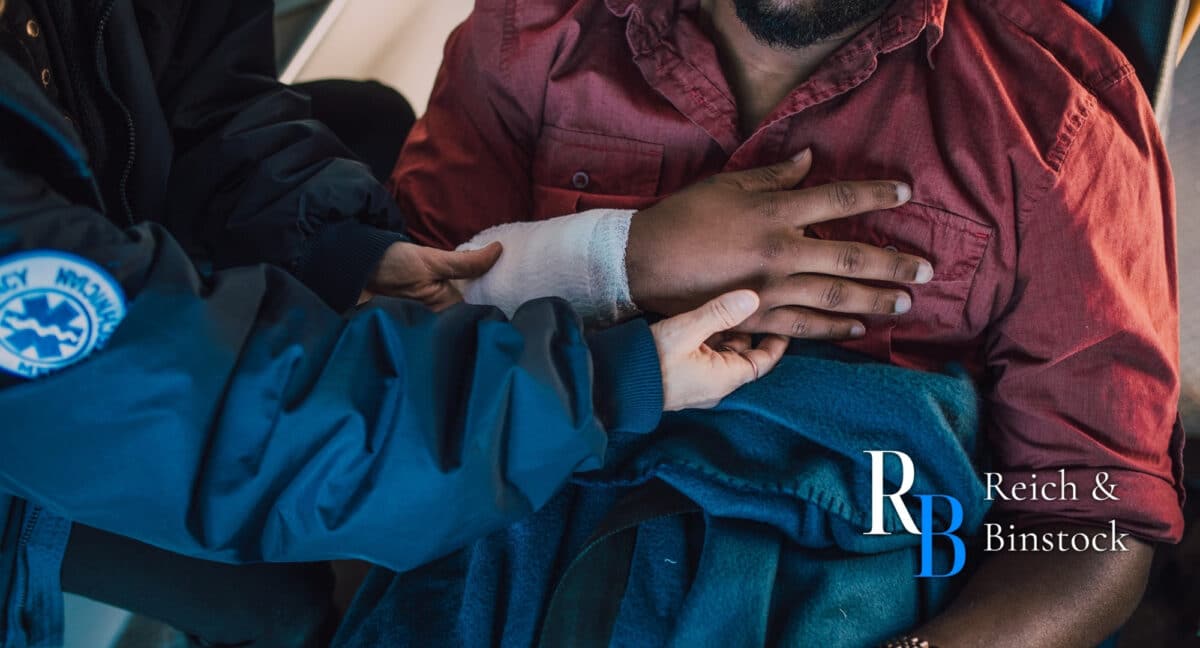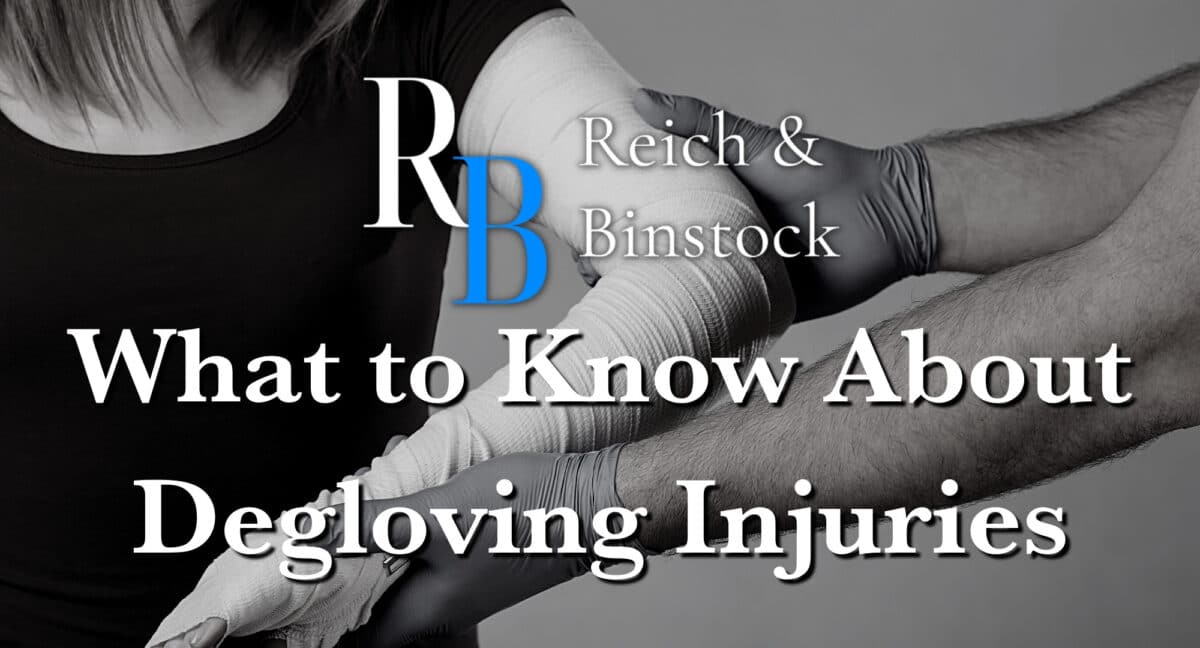A degloving injury can be an extremely traumatic thing for an accident victim to endure. These injuries involve a portion of the skin being ripped off of the body. They are extremely painful and have the potential to produce lifelong complications. If you are badly injured in a motor vehicle, industrial or farm equipment accident, you need an attorney who will fight for compensation.
At Reich & Binstock, our Houston personal injury lawyers are very passionate about helping injured victims. If you suffered degloving or soft tissue injuries, you need a catastrophic injury attorney who knows how to fight for full and fair compensation. To schedule a free consultation with us, please call 713-622-7271.
Degloving Injury Lawsuits
If your degloving injury resulted from negligence from another party, you might have a personal injury case. The vast majority of the degloving cases we see come from car accidents, truck accidents, and motorcycle accidents. However, they can also result from accidents involving farm equipment or heavy machinery. Read on to find out whether or not you have a case.
Degloving Is a Form of Catastrophic Injury
When we think of a catastrophic injury, we often picture victims who suffer paraplegia, quadriplegia, birth injuries, and loss of the senses. However, any injury that happens very suddenly and is very life-changing can be a catastrophic injury. Therefore, severe cases of degloving can absolutely be catastrophic in nature.
What Is Degloving?
These often life-threatening injuries can happen to nearly any part of the body, including the fingers, hands, arms, legs, and scalp. Specifically, a degloving injury occurs if the top layers of the skin are torn away from the underlying tissue. Most victims experience these soft-tissue injuries on their legs. In many cases, they are coupled with severe symptoms, including blood supply loss, tissue death, and damaged blood vessels.
Types of Degloving Injuries
There are two primary types of degloving injuries. These are open degloving injuries and closed degloving injuries.
Open Degloving Injury
Open degloving injuries involve the skin and tissue being torn away from the underlying muscle and soft tissue. In many cases, the skin is completely torn off. In others, a portion remains attached as a skin flap near the tear. The most common body parts that suffer this injury are the legs, scalp, face, and torso.
The following are the most common causes of open degloving injuries:
- Dog attacks or animal bites
- Sports injuries
- Falls from great heights
- Bad accidents involving industrial or farming equipment
- Traffic accidents with cars, trucks, or motorcycles
Closed Degloving Injury
In many cases, closed degloving injuries are harder to diagnose, as they are not always immediately visible. They often cause bruising, but this might be their only apparent symptom. This often leads to a delayed diagnosis for victims.
Closed degloving injuries involve the top layer of skin being separated from the underlying soft tissues. This leaves a space between the skin and the deeper tissues. Sometimes, these spaces fill up with different bodily fluids, including blood, fat, and lymph fluid.
Even though they are more difficult to identify, closed degloving injuries share common causes with open degloving injuries. The most common area for victims to experience closed degloving injuries is the hip bone area, specifically the greater trochanter area.
Other common areas for these degloving soft tissue injuries are as follows:
- Knees
- Buttocks
- Lower spine
- Torso
- Shoulder blades
Is Degloving an Amputation?
Amputations do not include degloving or avulsion injuries. Rather, OSHA defines an amputation as “the traumatic loss of a limb or other external body part.” One can interpret this definition as including degloving soft tissue injuries, but OSHA specifically excludes these. It is also important to note that amputations do not require any loss of bone. For example, if the very tip of the finger is cut off in a work accident, this can still be considered an amputation. However, avulsion injuries in which multiple fingers are affected are not considered amputations.
What to Do After a Degloving Injury

After severe injuries such as these, it is important to act quickly. The first step is to ensure that you receive an early versus delayed assessment of your injuries. Waiting to seek medical attention could not only lead to worse injuries, but it could also affect your compensation. It’s important to document the severity of your injuries in as much detail as possible. The more information you have in medical records, the better off your case will be.
Next, you should focus on reporting the accident that caused the degloved skin. Depending on how you sustained your injury, you should report them to the appropriate parties. In a work-related accident, report it to your employer right away and request a copy of the accident report. In a non-work accident, report it to the police and request a copy of the police report.
If you are able, take photos and videos of both your injuries and the scene of the accident. If you cannot manage this on your own, ask for help from a trusted party.
Politely decline early, lowball offers from insurance companies or responsible parties. You might feel tempted to accept an offer, especially as your medical bills pile up. However, it’s important to consult with an attorney before accepting any offers.
Hire an attorney with experience in catastrophic injury cases. Personal injury is often a complex area of law, which means it can be difficult to handle cases on your own. Attorneys can increase your chances of achieving maximum compensation for your life-threatening injuries.
What Causes Degloving Injuries?
As we mentioned before, open degloving involves the tearing of the skin away from the underlying fascia and underlying soft tissue of the area. Closed degloving is similar but does not involve tearing of the skin flaps. The avulsed skin flap remains connected to the rest of the skin but is still disconnected from the connective tissue underneath.
Degloving injuries are often a result of the following accidents:
- Dog bites and animal attacks
- Sports injuries
- Car accidents
- Truck accidents
- Motorcycle accidents
- Industrial and farming equipment accidents
While they can happen anywhere, the most common areas for degloved skin are the hands, legs, arms, and torso.
What Causes Facial Degloving?
Sometimes, victims can experience facial degloving. While this is a very rare occurrence, such cases can involve the eyelids, nose, ears, and even the jaw. This can be extremely painful and damaging for victims in a number of different ways. Treatment often requires complex skin repair, skin grafts, plastic surgery, physical therapy, and much more. Disfigurement of the face after degloving repair can greatly impact the mental and emotional health of victims. Such patients deserve compensation for this lapse in their quality of life.
How to Treat Degloving Injuries
Treatment options differ depending on the type and severity of the degloving injury. Diagnostic and therapeutic challenges for a degloving injury depend on location, depth, severity, and type. For mild cases, doctors often opt for simple plastic surgery, a skin graft, or skin flaps.
In more severe cases, a plastic surgery team might be called in. They might suggest extensive skin grafts, skin flaps, physical therapy, amputation, reconstructive surgery, and more. The earlier you enter treatment, the better your chances are of keeping as much skin as possible.
Infection risks are very high with these injuries, which is why you should seek medical treatment immediately. Once the skin is repaired, patients will likely need to wear compression bandages, much like burn victims do. Speak with your doctor about which treatment options are available for your specific injury.
Long-Term Effects of Degloving
Prognoses for degloving injuries vary mostly depending on the injured body part, the treatment results, and the severity. For example, a very minor, closed injury could produce little to no lasting effects. However, a complete degloving is likely to bring therapeutic challenges, and damage to extensor tendons, digital nerves, and digital arteries. The best way to achieve better results is to follow every step of your treatment protocol exactly.
Should I File a Personal Injury Claim After a Degloving Injury?

Degloving injuries are often extremely traumatic for victims. They produce excruciating pain, visible scarring from skin grafting, and sometimes damage to the underlying neurovascular bundle. Recovery and treatment are not cheap, meaning you’ll be saddled with extensive medical bills. Additionally, you will likely need some time off work to recover, which will interrupt your flow of income.
Maybe you suffer degloving injuries of the hand, and you have a job that requires extensive use of the hands. In this case, your injury greatly impacts your capacity to earn money. When an injured body part affects your daily life in a major way, you might experience depression or other mental and emotional problems. You deserve compensation for all of these reasons, and filing a personal injury claim can help you achieve that.
Most Common Degloving Personal Injury Cases
Ring avulsion injuries are another common form of degloving. If you frequently wear rings and work with your hands, you are at risk of ring avulsion injuries. These occur if your ring catches on an object and you pull your hand away forcefully. While they might seem minor at first, these upper extremity injuries can produce extreme pain from the shearing forces and skin tearing.
What Damages Can Degloving Injury Victims Recover?
It’s important to discuss the damages you can recover with your attorney. When another person’s actions or negligence cause your degloving injuries, you deserve compensation. There are two main types of compensation you can recover: economic and non-economic.
Economic Damages
These damages intend to recoup you for financial and out-of-pocket losses associated with the soft tissue injury. The purpose is to restore you to the financial state you were in before the injury ever happened.
They include the following expenses.
- Surgical costs
- Hospital fees
- Plastic surgery
- Lost wages
- Medications
- Rehabilitation and physical therapy
- Reduced earning capacity
Non-Economic Damages
These damages intend to help victims recover, heal from, and handle the emotional, physical, and mental pain they suffered. Even if there is no direct financial loss associated with them, they are still important in victim compensation.
They include the following expenses.
- Emotional distress
- Pain and suffering
- Scarring and disfigurement
- Loss of consortium
- Loss of quality of life
Who Is Liable for Degloving Injuries?
One of the most important aspects of your case will be assigning liability to all responsible parties. Who exactly can be held liable for your degloving injuries? If more than one person is at fault, you can assign liability to each of those people.
Potentially liable parties include the following:
- Employers or coworkers
- Negligent drivers or operators
- Property owners
- Landlords
- Companies that produce defective products
- Governments responsible for dangerous areas
Call Reich & Binstock to Speak with a Catastrophic Injury Lawyer
If you suffered degloving soft tissue injuries in Houston, you need an attorney with extensive experience handling catastrophic injuries. Call the personal injury lawyers at Reich & Binstock for compassionate yet aggressive representation. We will ensure that you receive full and fair compensation so that you can focus on your recovery. For more information or to schedule a free consultation, please call our office at 713-622-7271 today.













